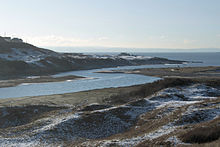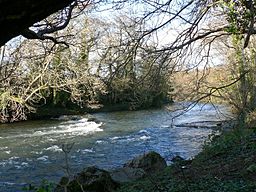- River Ogmore
-
River Ogmore (Afon Ogwr) River The Ogmore River at Pen-y-cae, north of Bridgend.Country Wales Tributaries - left Ewenny River - right River Llynfi, River Garw Cities Blackmill, Brynmenyn, Aberkenfig, Bridgend, Ogmore-by-Sea Source - location near the cemetery mountain, north of Treorchy Mouth - location Bristol Channel near Ogmore-by-Sea - coordinates 51°28′11″N 3°38′18″W / 51.46972°N 3.63833°W The River Ogmore (Afon Ogwr in Welsh) is a river in South Wales popular with anglers. It runs generally from north to south from the Ogmore Vale and Pentre, past Bridgend and Ogmore. The river Ogmore is generally considered to start near the cemetery mountain, north of Treorchy, although it is known as the Ogwr Fach, with the Ogwr Fawr, coming from Gilfach to the east merging near Blackmill. The River Llynfi, the River Garw and finally the River Ewenny in its estuary are all tributaries of the Ogmore which flows into the sea between Ogmore-by-Sea and the Merthyr Mawr sand-dunes.
Contents
Geology and Geography
Most of the headwaters flow over carboniferous coal measures overlain by glacial drift and fluvial gravels. The valleys are reasonably broad for a small river and many of the tributaries meandered through their valleys in the past. The considerable urbanisation, especially in the 19th century confined most rivers to rather narrow artificial channels bordered in places such as Bridgend with concrete flood protection walls.
Major tributaries
River Llynfi
The River Llynfi (Afon Llynfi in Welsh), runs for around 10 miles from its source north of Maesteg and flows generally southwards through the Llynfi Valley to the confluence with the River Ogmore at Aberkenfig.[1]
Afon Garw
The Garw flows broadly north-south and runs through Pontycymer to its confluence with the Ogmore (Ogwr) at Brynmenyn.
River Ewenny
 The river enters the Bristol Channel at Ogmore-by-Sea, at a popular beach called Traeth-yr-Afon.
The river enters the Bristol Channel at Ogmore-by-Sea, at a popular beach called Traeth-yr-Afon.
The Ewenny River (Welsh: Afon Ewenni) rises to the north-east of Bridgend town and flows through Pencoed and Coychurch before entering the River Ogmore estuary just below Ogmore Castle.
Environment
The industrialisation of the valley of the Ogmore by mining and heavy industry severely damaged much of the natural environment of the river. However, there has been an improvement in recent years and it supports a healthy population of aquatic inveterbrates. The river does still have some problems though, including its proximity to major industrial plants, insensitive developement and invasive weeds.[2]
Estuary
Until some years ago, the adjacent sewage works discharged effluents into the estuary, but the water outlets have since been treated with ultraviolet light and do not flow frequently into the river. However, in periods of heavy rain, emergency outfalls pour into the river, releasing some sewage. [3]
Fishery
In its industrial heyday, the Ogmore was devoid of salmonid fish throughout much of its length although brown trout survived in many of the smaller tributaries.
From the 1980 onwards, Salmon and sea-tout started returning to the main river and the River Garw in ever-increasing numbers but continued to avoid the chronically polluted Llynfi. However, even on the Llynfi, native brown trout numbers increased upstream of Tondu and these were occasionally supplemented by stocked Rainbow trout. In all parts of the river, trout can now be found with Salmon and sea-trout almost everywhere. In addition eels remain common with Millers Thumb, Gudgeon, Stone loach and Minnow present ubiquitously.
References
- ^ Ordnance Survey Explorer maps 151 'Cardiff & Bridgend/Caerdydd & Phen-y-bont-ar-Ogwr' and 166 'Rhondda & Merthyr Tydfil/Merthyr Tudful'
- ^ "The River Ogmore". Rivers. The South East Wales Rivers Trust. http://www.southeastwalesriverstrust.org.uk/rivers/river_ogmore.htm. Retrieved 30 May 2011.
- ^ [1]
External links
Categories:- Rivers of Wales
- Bridgend County Borough
Wikimedia Foundation. 2010.


